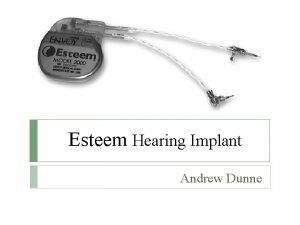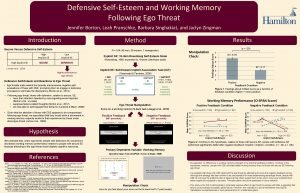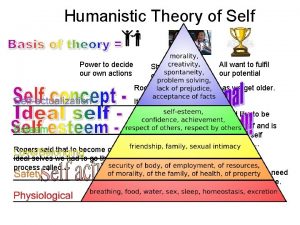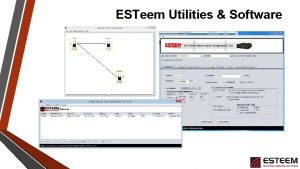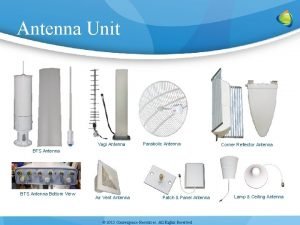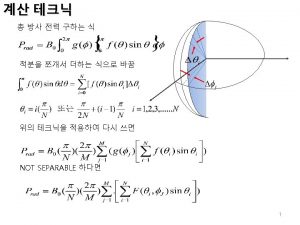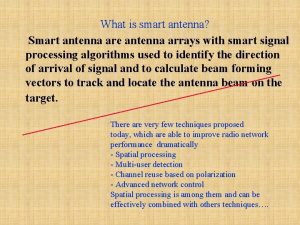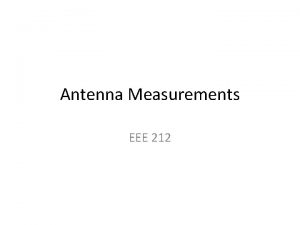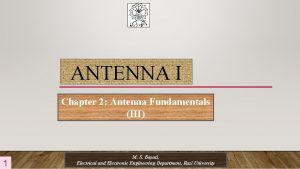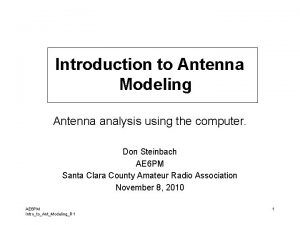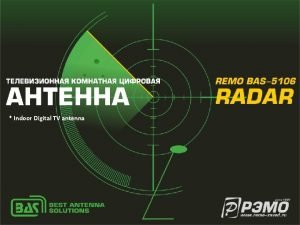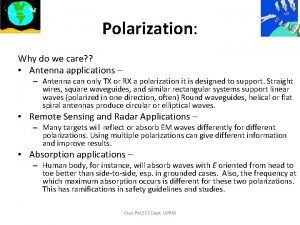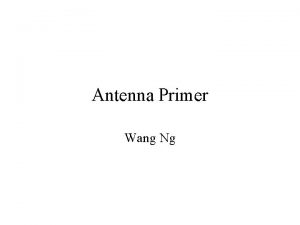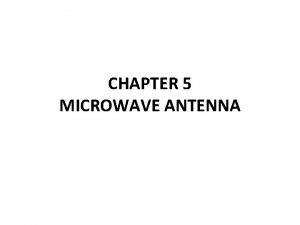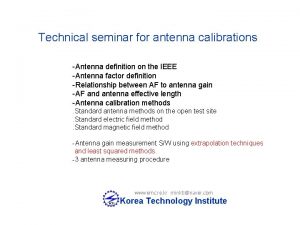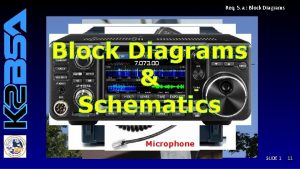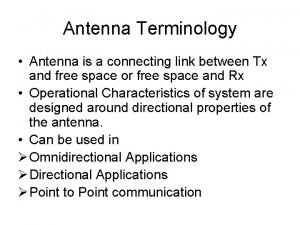ESTeem Training Class Antenna Fundamentals Introduction The antenna
































































- Slides: 64

ESTeem Training Class Antenna Fundamentals

Introduction • The antenna is the interface transmission line and space between the • Antennas are passive devices; the power radiated cannot be greater than the power entering from the transmitter • When speaking of gain in an antenna, gain refers to the idea that certain directions are radiated better than others • Antennas are reciprocal - the same design works for receiving systems as for transmitting systems

Decibels (d. B) • Used for all mathematical calculations in the radio world. – d. B is a logarithmic number • d. B =10 log (linear number) – – A gain of 2 = 10 log (2) = 3 d. B A gain of 4 = 10 log (4) = 6 d. B When a number doubles it goes up 3 d. B When a number reduces by 1/2, it goes down -3 d. B – To multiply linear numbers you add logarithms – To divide linear numbers you subtract logarithms

Antenna Gain • Antenna Gain measure in decibels (d. B) – Double every 3 d. B • Effective Radiated Power (ERP) = Tx Power + Antenna Gain - Feedline Losses • Received Signal = Rx Power + Antenna Gain - Feedline losses • As Antenna Gain increases Antenna Pattern becomes more directional

Radiation Patterns • Omni-Directional / Isotropic – Radiates RF energy in all directions from antenna RF Energy Antenna Top View

RF Basics - Omni-Directional Antennas • Omni-Directional / Isotropic Antenna – Radiates RF energy in all directions from antenna – Usually used at the Master and Repeater Nodes Omni-directional Antenna Vertical Polarized 360 degrees Top View Radiation Pattern Vertical Polarization Side View Radiation Pattern Vertical Polarization

RF Basics - Antenna Gain • As Antenna Gain increases the Antenna Pattern becomes more directional Omni- Directional Antenna Shown Below 3 d. B Points 360 degrees Remains Unchanged Top View Radiation Pattern Vertical Polarization Vertical Beam Width (degrees) Side View Radiation Pattern Vertical Polarization

Radiation Patterns • Directional – Compresses RF Energy in one direction RF Energy Antenna Top View

RF Basics - Directional Antennas • Directional – Radiates RF energy in one direction – Usually used at Remote Nodes in a Point to Multi-point system or Point to Point Site 3 d. B Points Vertical Beam Width (degrees) Horizontal Beam Width (degrees) Back Lobe Top View Radiation Pattern Vertically Polarized Side View Radiation Pattern Vertically Polarized

RF Basics - Antenna Gain • As Antenna Gain increases the Antenna Pattern becomes more directional Directional Antenna Shown Below 3 d. B Points Horizontal Beam Width (degrees) Vertical Beam Width (degrees) Back Lobe Top View Radiation Pattern Vertically Polarized Side View Radiation Pattern Vertically Polarized

Antenna Polarization • Vertical Or Horizontal Polarization – Polarization is the radiating element referenced to earth – All nodes must be the same polarization • Cancellation of signal if mismatched – Vertical Polarization for Most Radio Applications • Mixture of Omni and Directional Antennas • No Horizontal Polarization of Omni-Directional Antenna Vertical Polarized Omni-directional Antenna Vertical Polarized Directional Antenna Horizontal Polarized

Antenna Types • 1/2 Wave Antenna – Close to Isotropic Radiation – Approximately 3 d. B gain – No ground planes needed



Antenna Gain Specifications • d. Bi means decibels with respect to an isotropic radiator • d. Bd means decibels with respect to an ideal half-wave dipole in its direction of maximum radiation • The gain of a dipole is 2. 14 d. Bi

Beamwidth The width of this bean is defined as the angle between its half-power points. A half-wave dipole has a beamwidth of about 79º in one plane and 360º in the other

Antenna Theory • An antenna is a transducer designed to transmit or receive electromagnetic waves. • The official IEEE definition of an antenna is “That part of a transmitting or receiving system that is designed to radiate or receive electromagnetic waves”. Radiation from an Antenna • Radiation of antenna can be explained by using capacitor concept. • During positive half cycle of current capacitor charges with upper plate positive and lower plate negative chargers. This creates electric line of forces and there direction is from top to bottom. • In anticlockwise direction of current, polarity reverses and electric lines of forces become bottom to top.

Radiation From an Antenna • When current flowing in one direction and is required to reverse their direction rapidly, those lines of forces at the extreme edge are unable to make this change with sufficient rapidly and are forced to out of the system. • In this way a certain amount of energy, stored in capacitor is radiated during each cycle. This affect increases with frequency, so that at radio frequencies, efficient radiations obtained from the conductor i. e. antenna.

Field Regions of Antenna • The fields surrounding an antenna are divided into 3 principle regions: – Reactive Near Field – Radiating Near Field or Fresnel Region – Far Field or Fraunhofer Region

Field Regions of Antenna Reactive Near Field Region • In the immediate vicinity of the antenna, we have the reactive near field. • In this region, the fields are predominately reactive fields, which mean the E- and H- fields are out of phase by 90 degrees to each other. • In this region, energy is only stored and no energy is dissipated. The boundary of this region is commonly given as: Where R is the distance from the antenna surface, D is the largest dimension of the antenna and λ is the wavelength

Field Regions of Antenna Radiating Near Field (Fresnel) Region • The radiating near field or Fresnel region is the region between the near and far fields. • Reactive fields are smaller in this field as compared to the reactive near-field region and the radiation fields dominate. The outermost boundary for this region is given by: Where R is the distance from the antenna surface, D is the largest dimension of the antenna and λ is the wavelength

Field Regions of Antenna Far-field region (Fraunhofer region) • The region beyond is the far field region. • In this region, the reactive fields are absent and only the radiation fields exist; with the E- and H-fields orthogonal to each other and the direction of propagation as with plane waves. • The far field region is the most important, as this determines the antenna's radiation pattern. • Also, antennas are used to communicate wirelessly from long distances, so this is the region of operation for most antennas.

Antenna Performance Parameters Radiation Pattern An antenna radiation pattern or antenna pattern is defined as “a mathematical function or a graphical representation of the radiation properties of the antenna as a function of space coordinates”. In most cases, the radiation pattern is determined in the far field region and is represented as a function of the directional coordinates. Directivity of an antenna defined as “the ratio of the radiation intensity in a given direction from the antenna to the radiation intensity averaged over all directions”. It may be regarded as the ability of the antenna to direct radiated power in a given direction.

Antenna Performance Parameters Antenna Efficiency The efficiency of an antenna relates the power delivered to the antenna and the power radiated or dissipated within the antenna. The antenna efficiency (or radiation efficiency) can be written as the ratio of the radiated power to the input power of the antenna: Antenna Gain The term Antenna Gain describes how much power is transmitted in the direction of peak radiation to that of an isotropic source. Antenna Gain (G) can be related to directivity (D) by: Thus, Antenna gain is defined as antenna directivity times a factor representing the radiation efficiency.

Antenna Performance Parameters Return Loss is the measure of the amount of power which is reflected back to the source from an incorrectly terminated line. Return loss is expressed in d. B as: Where Pi is the incident power and Pr is the reflected power. There are many types of antennas but for the study of Specific Absorption Rate, dipole antenna is best due to its simple structure and isotropic radiation pattern.

Dipole / Doublet H

The Dipole Antenna Some of the basic parameters of a half wave dipole antenna are as described below: Radiation pattern Dipoles have a radiation pattern, shaped like a toroid (doughnut) symmetrical about the axis of the dipole. The radiation is maximum at right angles to the dipole, dropping off to zero on the antenna's axis.

The Dipole Antenna Frequency versus length The length of a half-wave dipole l, for frequency f hertz is given by the formula: Where λd is the wavelength on the dipole elements, λ 0 is the free-space wavelength, c is the speed of light in free space (299, 792, 458 meters per second) and k is an adjustment factor (typically from 0. 95 to about 0. 915) Current and voltage distribution

Phased Array Antennas • For some applications single element antennas are unable to meet the gain or radiation pattern requirements. • A proper combination of various types of antennas might yield the required pattern. • Thus there is control over the direction in which the power is transmitted. • An antenna array is a cluster of antennas arranged in a specific physical configuration. • Each individual antenna is called an element of the array. • The excitation (both amplitude and phase) applied to each individual element may differ. • Once an array has been designed to focus towards a particular direction, it becomes a simple matter to steer it towards some other direction by changing the relative phases of the array elements; a process called steering or scanning.

Zero Phase Shift Animation

Constant Phase Shift Animation

YAGI–UDA ANTENNA Most high gain antennas 3 elements: Driven element Parasitic element Spacing = 0. 1 to 0. 25 Parasitic element Director Reflectors Dipole impedance = 73 ohms 32

Yagi-Uda Antenna (Yagi) • One driven element and one or more parasitic elements • Operates over a small range of frequencies (not a wideband antenna)

Yagi Antenna – 3 elements § A 3 element Yagi Associated radiation pattern

Log-Periodic Antenna • Lengths of driven elements are related logarithmically • The longest element has a length of ½ the wavelength of the lowest frequency • The shortest element is ½ the wavelength of the highest frequency • Advantage is very wide bandwidth

Log-Periodic Antenna Ratio of two adjacent elements is held constant, usually 0. 7 -0. 9


Log periodic Antenna • Electrical properties must repeat periodically with the logarithm of frequency • Basic geometric structure that is repeated but with a changing size • Structure size changes with each repetition by a constant scale factor so that the structure expand or contract

Log Periodic Dipole Array • LPDA • All the dimensions increase in proportion to the distance from the origin

LPDA n n n No. of dipoles of different lengths and spacings Fed by a balanced two wire t. Xion line Included angle is constant Length =L Spacing=R Scale factor or design ratio <1

LPDA • Properties at frequency f , the same properties will be repeated at freq nf or f/ n



Antenna Arrays • Simple antennas can be combined to achieve desired directional effects • Individual antennas are called elements and the combination is an array

Types of Arrays • Broadside: maximum radiation at right angles to main axis of antenna • End-fire: maximum radiation along the main axis of antenna • Phased: all elements connected to source • Parasitic: some elements not connected to source – They re-radiate power from other elements

Broadside Array • Bidirectional Array • Uses Dipoles fed in phase and separated by 1/2 wavelength


End-Fire Array • Similar to broadside array except dipoles are fed 180 degrees out of phase • Radiation max. off the ends


Log-Periodic Dipole Array • Multiple driven elements (dipoles) of varying lengths • Phased array • Unidirectional end-fire • Noted for wide bandwidth • Often used for TV antennas


4. 6 Helical Antennas Diameter of ground plane at least 3λ/4

Helical Antennas (Cont’d. . )


The Helical Antenna • Several types of antennas are classified as helical • The antenna in the sketch has its maximum radiation along its long axis • A quarter-wave monopole can be shortened and wound into a helix— common in rubber ducky antenna

Loop Antennas • Sometimes, smaller antennas are required for certain applications, like AM radio receivers • These antennas are not very efficient but perform adequately • Two types of loop antennas are: – Air-wound loops – Ferrite-core loopsticks


Discone Antennas






 Esteem software
Esteem software Constructor in java
Constructor in java Self concept definition
Self concept definition Definition of selfesteem
Definition of selfesteem Self esteem objectives
Self esteem objectives Self image vs self perception
Self image vs self perception All thoughts
All thoughts Self esteem definition
Self esteem definition Self-concept beliefs
Self-concept beliefs Self image vs self perception
Self image vs self perception Self image vs self perception
Self image vs self perception Personality self esteem and emotions
Personality self esteem and emotions Self esteem quiz printable
Self esteem quiz printable Identity diffusion example
Identity diffusion example Self esteem erikson
Self esteem erikson The five building blocks of self-esteem
The five building blocks of self-esteem Define parity of esteem
Define parity of esteem Self-esteem needs
Self-esteem needs Esteem implant
Esteem implant Chapter 3 lesson 2 health
Chapter 3 lesson 2 health Sociometer theory of self-esteem
Sociometer theory of self-esteem Short term goals for self-esteem
Short term goals for self-esteem Short term goals for self-esteem
Short term goals for self-esteem Self esteem goals and objectives
Self esteem goals and objectives Defensive self esteem
Defensive self esteem Kepimpinan dan motivasi
Kepimpinan dan motivasi The costly pursuit of self-esteem
The costly pursuit of self-esteem Low self esteem meaning
Low self esteem meaning Advocacy about self confidence
Advocacy about self confidence Self esteem adalah
Self esteem adalah Low self esteem
Low self esteem Rosenberg self esteem scale 1965
Rosenberg self esteem scale 1965 Poker chips self esteem
Poker chips self esteem Chapter 2 personality self-esteem and emotions
Chapter 2 personality self-esteem and emotions Joints
Joints Hát kết hợp bộ gõ cơ thể
Hát kết hợp bộ gõ cơ thể Frameset trong html5
Frameset trong html5 Bổ thể
Bổ thể Tỉ lệ cơ thể trẻ em
Tỉ lệ cơ thể trẻ em Voi kéo gỗ như thế nào
Voi kéo gỗ như thế nào Glasgow thang điểm
Glasgow thang điểm Chúa yêu trần thế alleluia
Chúa yêu trần thế alleluia Các môn thể thao bắt đầu bằng tiếng đua
Các môn thể thao bắt đầu bằng tiếng đua Thế nào là hệ số cao nhất
Thế nào là hệ số cao nhất Các châu lục và đại dương trên thế giới
Các châu lục và đại dương trên thế giới Công của trọng lực
Công của trọng lực Trời xanh đây là của chúng ta thể thơ
Trời xanh đây là của chúng ta thể thơ Cách giải mật thư tọa độ
Cách giải mật thư tọa độ Làm thế nào để 102-1=99
Làm thế nào để 102-1=99 Phản ứng thế ankan
Phản ứng thế ankan Các châu lục và đại dương trên thế giới
Các châu lục và đại dương trên thế giới Thể thơ truyền thống
Thể thơ truyền thống Quá trình desamine hóa có thể tạo ra
Quá trình desamine hóa có thể tạo ra Một số thể thơ truyền thống
Một số thể thơ truyền thống Cái miệng nó xinh thế chỉ nói điều hay thôi
Cái miệng nó xinh thế chỉ nói điều hay thôi Vẽ hình chiếu vuông góc của vật thể sau
Vẽ hình chiếu vuông góc của vật thể sau Thế nào là sự mỏi cơ
Thế nào là sự mỏi cơ đặc điểm cơ thể của người tối cổ
đặc điểm cơ thể của người tối cổ V cc cc
V cc cc Vẽ hình chiếu đứng bằng cạnh của vật thể
Vẽ hình chiếu đứng bằng cạnh của vật thể Vẽ hình chiếu vuông góc của vật thể sau
Vẽ hình chiếu vuông góc của vật thể sau Thẻ vin
Thẻ vin đại từ thay thế
đại từ thay thế điện thế nghỉ
điện thế nghỉ Tư thế ngồi viết
Tư thế ngồi viết


















